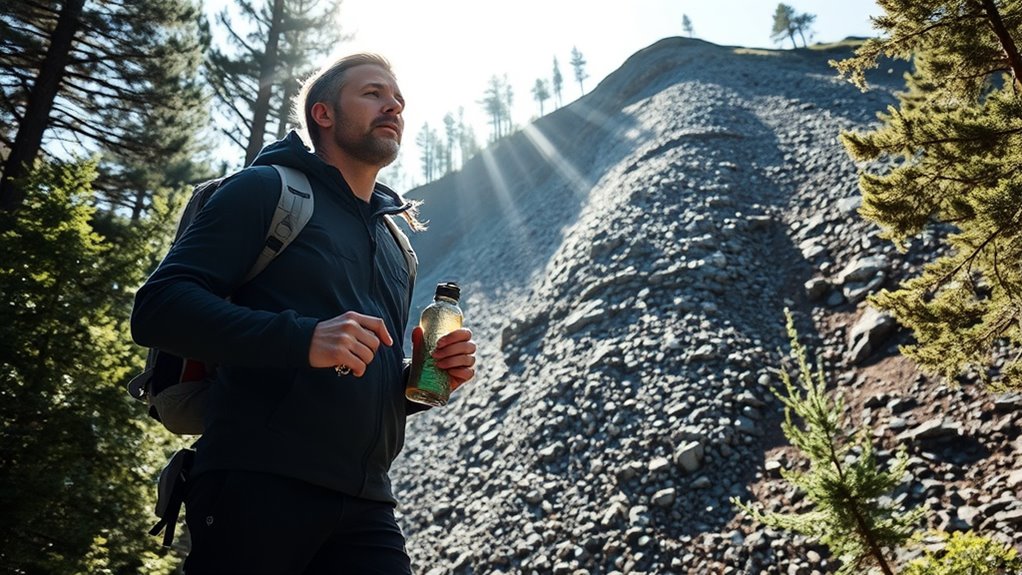To train for your first hill climb challenge, focus on building endurance and strength with a structured plan. Incorporate VO2max intervals and steady endurance rides into your routine while allowing time for recovery. Prioritize nutrition by eating complex carbs before rides and staying hydrated throughout. Utilize tools like Strava to find local climbs and track your progress. By following these strategies, you’ll enhance your performance and confidence for the challenge ahead, with more tips to help you succeed.
Key Takeaways
- Build a solid aerobic base through consistent endurance rides, gradually increasing climb duration by 5 minutes each week.
- Incorporate at least two VO2max training sessions weekly to enhance anaerobic capacity and climbing power.
- Focus on a balanced training plan that mixes high-intensity efforts with steady-state rides for optimal recovery and performance.
- Utilize technology like Strava to track progress, analyze climb times, and identify local climbs for targeted training.
- Develop mental strategies, including visualization and positive self-talk, to boost confidence and resilience during climbs.
Understanding the Importance of Endurance and Strength

When you tackle a hill climb challenge, understanding the importance of endurance and strength is key to your success. Endurance allows you to sustain efforts that often exceed 20 minutes, so developing a solid aerobic base is essential.
You’ll need to maintain a consistent power output throughout the climb. Incorporating strength training, like high-gear pedaling at low cadence, boosts your muscular endurance and power, enhancing your climbing performance.
Don’t forget about VO2max work; intervals of 5-10 minutes are vital for improving your ability to sustain high efforts. Balancing endurance rides with strength training sessions will optimize your climbing capacity, ensuring you adapt and progress effectively as you prepare for your first hill climb challenge. Additionally, utilizing wellness tracking tools can help monitor your training progress and recovery.
Crafting a Structured Training Plan

To craft an effective training plan, you need to establish a consistent session frequency that includes VO2max workouts and endurance rides. Focus on workout specificity to target your hill climbing goals, ensuring each session contributes to your overall performance. Incorporating multi-functional gear into your training can enhance your overall efficiency and adaptability during the climb.
Training Session Frequency
While developing a structured training plan, aim for at least two focused sessions each week that concentrate on VO2max and hill climbing efforts. Complement these with high-intensity interval training (HIIT) and steady-state endurance rides to balance your performance. Gradually increase your hill climb duration by 5 minutes each week, working towards sustained efforts of up to 45 minutes. Schedule rest days to optimize recovery, helping you consistently train at high intensities. Additionally, consider the impact of proper equipment calibration on your overall performance during training sessions.
| Day | Workout Type | Duration |
|---|---|---|
| Monday | VO2max Intervals | 30 minutes |
| Wednesday | Hill Climbing | 40 minutes |
| Saturday | Endurance Ride | 60 minutes |
Incorporate local climbs to simulate race conditions for your hill climbing challenge!
Specificity in Workouts
Building on your training session frequency, specificity in your workouts is key to preparing effectively for a hill climb challenge.
To enhance your power and endurance, structure your training plan with focused sessions that mimic hill climb demands. Here’s how:
- Incorporate at least two VO2max sessions per week, with 5-10 minute efforts at 95%-100% of your FTP.
- Gradually increase hill climb duration, starting at 15-20 minutes and adding 5 minutes weekly.
- Mix steady-state lactate threshold efforts with high-intensity intervals.
- Track your Watts per Kilogram (W/Kg) to monitor improvements.
- Aim for a significant increase in climbing speed by balancing power output and weight management.
This specificity will guarantee you’re fully prepared for your hill climb challenge!
Balancing Intensity and Recovery

Balancing intensity and recovery is essential for achieving peak performance in hill climb challenges. To enhance your anaerobic capacity, incorporate two VO2max training sessions each week, focusing on short, intense efforts.
Pair this high-intensity work with steady-state rides and zone 2 training to build a solid aerobic base while allowing adequate recovery. Prioritize rest days and adjust your training intensity based on your body’s responses to avoid burnout and fatigue.
A structured weekly schedule will help you mix hard efforts with lighter rides, ensuring you’re fresh for weekend climbs or races. Additionally, track your performance and recovery metrics, like heart rate variability and perceived exertion, to fine-tune your training and recovery balance for best results. Incorporating hydration strategies is crucial; water intake aids in maintaining optimal brain function during intense training sessions.
Utilizing Strava for Hill Selection

Strava makes it easy to discover local climbs that fit your training needs.
By analyzing climb metrics, you can choose routes that challenge your endurance and VO2max.
Plus, tracking your performance progress against others keeps you motivated and focused on improvement. Additionally, incorporating proper hydration and nutrition can significantly enhance your training results.
Discover Local Climbs
Finding the right climbs for your training can make all the difference in preparing for a hill climb challenge. Strava is a powerful tool to help you discover local climbs tailored to your needs.
Here’s how to make the most of it:
- Use Strava’s heatmap to pinpoint popular climbs in your area.
- Check segment leaderboards to assess difficulty and competitiveness.
- Filter segments by length and gradient to match your training goals.
- Join local cycling clubs on Strava for insider tips on hidden climbs.
- Track your progress by recording climb times and comparing them over time.
- Consider how human-centered roles in sports coaching can enhance your training experience.
With these strategies, you’ll create a diverse and effective training plan that prepares you for your challenge ahead.
Analyze Climb Metrics
Once you’ve identified local climbs, the next step is to analyze the metrics that define each climb’s difficulty. Use Strava’s segment feature to gather essential climb metrics, like average gradient, total elevation gain, and segment times.
These figures help you gauge how challenging each hill might be for your upcoming hill climb challenge. Pay attention to the average gradient; steeper climbs require more effort.
Strava’s heatmaps can also reveal popular routes and typical conditions faced by other cyclists. By comparing your performance on these climbs against others and noting your times, you’ll better understand your strengths and weaknesses.
This analysis will guarantee you select climbs that effectively prepare you for race day. Additionally, consider hydrating with fresh juices, as freshly squeezed juices can provide essential nutrients and energy for your training sessions.
Track Performance Progress
Tracking your performance progress is essential for success in hill climbing. Using Strava effectively can help you focus on your climb times and achieve your training goals. Here are some tips to enhance your training:
- Explore local hills by checking segments and leaderboards.
- Monitor your time, power output, and heart rate on specific climbs.
- Compare your climb times with past performances and other riders.
- Create custom workouts that target various hills for a balanced routine.
- Set specific improvement goals, like reducing your time on a climb by a certain percentage.
Additionally, be mindful of state tax implications when planning your retirement, as they can affect your overall financial strategy.
Incorporating VO2max and Interval Training

To effectively prepare for a hill climb challenge, incorporating VO2max and interval training is essential, as these methods boost your aerobic capacity and power output.
Aim for two VO2max sessions weekly, focusing on short, intense efforts of 5 to 10 minutes to enhance your climbing ability. Utilize high power one-minute intervals, like Bashful or Bird workouts, to improve your anaerobic capacity and climbing power output.
Incorporate two weekly VO2max sessions with intense 5-10 minute efforts to boost climbing performance and anaerobic capacity.
Don’t forget to include 3-minute efforts, such as Spencer variations, to develop endurance and strength for sustained climbs. As you progress, increase the length of your intervals while maintaining intensity at 95%-100% of your Functional Threshold Power (FTP).
Additionally, consider adjusting your tire pressure to optimize your performance on varied terrain during training rides. Monitor your recovery to prevent burnout and guarantee consistent improvements in your VO2max and climbing performance.
Mental Strategies for Climbing Success

As you prepare for a hill climb challenge, mental strategies play an essential role in your success. To enhance your mental game, consider the following techniques:
- Visualize the climb beforehand to reduce anxiety and focus on your pacing.
- Engage in positive self-talk during your training to build resilience and confidence.
- Set small, achievable goals throughout the climb to maintain motivation.
- Develop a pre-climb routine that includes relaxation techniques like deep breathing or meditation.
- Embrace the discomfort of climbing as a part of the process, fostering a positive mindset.
- Remember that setting clear goals can provide a roadmap for your climb, helping to keep you focused and motivated.
Nutrition and Hydration for Optimal Performance

Nutrition and hydration can greatly impact your performance during a hill climb challenge, so it’s crucial to plan accordingly. Start with a pre-ride meal rich in complex carbohydrates, like oatmeal or whole grain bread, about 3-4 hours before the event. This fuels your body for sustained energy.
A light snack, such as a banana, 30 minutes prior offers quick carbohydrates. During the climb, aim for 30-60 grams of carbohydrates per hour through energy gels or sports drinks to stave off fatigue.
Don’t forget hydration; drink 500-1000 ml of water or electrolyte solutions beforehand, adjusting for sweat rates.
After the climb, recovery nutrition is important—consume protein and carbohydrates within 30 minutes to aid muscle repair and replenish energy stores.
Tracking Progress and Adjusting Your Plan

Achieving ideal performance in a hill climb challenge goes beyond just nutrition and hydration; tracking your progress is equally important.
To guarantee you’re on the right path, consider these strategies:
- Use a power meter to measure watts per kilogram (W/Kg) for evaluating climbing strength.
- Record your climb times and analyze speed metrics on platforms like Strava.
- Incorporate regular time trials to establish benchmarks and improve your endurance.
- Adjust your training plan based on recovery feedback; if you’re struggling, tweak intensity or add rest days.
- Set specific, measurable goals, like improving your climb time by a percentage or boosting power output.
Frequently Asked Questions
How Do I Strengthen My Legs for Uphill Cycling?
To strengthen your legs for uphill cycling, incorporate high-gear pedaling sessions on flat terrain, focusing on low cadence to engage your major muscle groups.
Add hill repeats to your routine, gradually increasing intensity while maintaining close to your Functional Threshold Power.
Don’t forget VO2max training twice a week with short, intense efforts.
Off the bike, perform strength exercises like squats and lunges to boost overall leg power and stability.
Monitor your weight-to-power ratio for peak performance.
How to Train for Uphill?
“Practice makes perfect!”
To train for uphill cycling, incorporate two VO2max sessions weekly with intense efforts of 5 to 10 minutes.
Gradually extend your climbs, starting at 15-20 minutes and adding 5 minutes each week until you reach 45 minutes.
Use a power meter to monitor your performance, alternating between seated and standing positions for better glute activation.
Don’t forget to mix in endurance rides for a solid aerobic base and recovery!
How to Train for Uphill Biking?
To train for uphill biking, focus on incorporating two VO2max sessions per week, emphasizing short, intense efforts.
Gradually increase your hill climb duration by 5 minutes each week, starting with 15-20 minutes and working up to 45.
Use a power meter to track your watts per kilogram, and include varied intensity workouts like hill repeats.
Consistency and recovery are essential, so balance high-intensity sessions with endurance rides to prevent burnout and adapt effectively.
How Do You Do a Perfect Start in Hill Climb?
You might think a perfect start in a hill climb is all about sheer power, but it’s more nuanced.
Begin seated to maintain control and traction, then shift to standing as the slope steepens. Use the right gear to switch from a low to a higher cadence smoothly.
Focus on explosive efforts for the first five minutes, aiming for 105-110% of your FTP.
Practice hard starts on flat terrain to build confidence and strength.
Conclusion
As you gear up for your first hill climb challenge, remember that consistent training and proper nutrition are key. Did you know that cyclists can burn up to 600 calories per hour while climbing? By focusing on endurance, strength, and mental strategies, you’ll not only conquer those peaks but also enjoy the journey. Keep tracking your progress and adjusting your plan, and you’ll be ready to tackle any hill with confidence. You’ve got this!
















